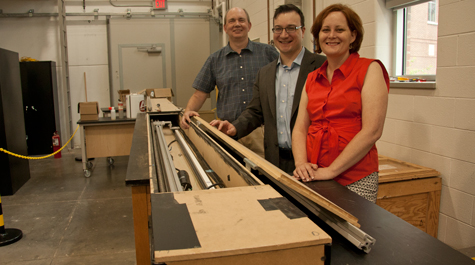W&M physicists help close the door on faster-than-light neutrinos
William & Mary’s Patricia Vahle addressed the scientific world on June 8, giving an overview of the latest news on the study of neutrinos.
Her first topic reported on the latest and most accurate measurements related to neutrino oscillation—the mid-flight changing of “flavors” of these subatomic particles. The second topic carried assurances that Einstein is still right and the laws of physics do not require rewriting—neutrinos do not travel faster than light.
Vahle, an assistant professor at William & Mary, is one of a group of particle physicists at the College working at MINOS, a long-baseline neutrino experiment at Fermi National Accelerator Laboratory in Illinois. Other members of W&M’s Department of Physics working on the MINOS are Assistant Professor Michael Kordosky, Cornelia B. Talbot Term Distinguished Associate Professor Jeffrey Nelson and graduate student Alena Devan.
The neutrino speed results reaffirm elements of Einstein’s special theory of relativity that state that nothing can travel faster than the speed of light. This constant was thrown into doubt last October when scientists at OPERA, a European neutrino experiment, reported observing neutrinos traveling slightly faster than the speed of light.
“The reason why the original OPERA result was so intriguing is that Einstein’s theory of relativity tells us that nothing can travel faster than the speed of light. All of modern physics is based on the ideas of relativity,” Vahle explained. “So to have found a particle that moved faster than the speed of light would have been really dramatic. We would have really had to think how relativity plays into everything we think we know and our interpretations would change.”
The OPERA result was later found to be caused by a hardware error, but the announcement carried implications startling enough to prompt neutrino experimenters around the world to double- and triple-check neutrino speed. Vahle explained that MINOS scientists crunched their time-of-flight numbers from seven years of study and their results reaffirmed the prevailing belief that neutrinos are traveling at—or very close to—the speed of light.
"Our measurement clocks the neutrinos as arriving 15 nanoseconds before we would expect them if they were traveling at the speed of light, but the margin of error around our measurement is 31 nanoseconds,” she said, “meaning our measurement is consistent with neutrinos traveling at the speed of light."
She said that scientists from OPERA and all other neutrino experiments associated with CERN formally presented revised findings, reporting neutrino times of flight at the speed of light—consistent with the MINOS findings, Vahle said, adding that OPERA’s margin of error, is tighter than the MINOS measurements.
She noted that the MINOS figures are important in that MINOS is a similar experiment to OPERA, at least as far as neutrino speed measurement is concerned. The neutrino beams of both MINOS and OPERA travel underground, through hundreds of miles of rock.
“At MINOS, we make our own beam of neutrinos at Fermilab,” she explained. “We have a near detector one kilometer away and a far detector, which is 735 kilometers away. It’s in Northern Minnesota and it’s half a mile underground.”
Multiple verification that neutrinos travel at or near to (but not faster than) the speed of light returns the focus to neutrino oscillation, Vahle’s other topic at the June 8 meeting.
“MINOS was built to look for a type of neutrino we call a muon neutrino changing into some other type of neutrino as it travels,” she explained. The changing of types, also known as “flavors,” is known as oscillation. Vahle explains that understanding oscillation among the three neutrino flavors is key to understanding neutrino behavior. Her Fermilab talk outlined the latest and most precise measurements in neutrino oscillation and addressed evidence of a secondary mode of neutrino oscillation.
“We look for muon neutrinos disappearing. We think that muon neutrinos are transiting into tau neutrinos. We can’t see tau neutrinos, but we can see muon neutrinos going away,” she explained. “But there’s also a small mode of oscillations where these muon neutrinos turn into electron-type neutrinos. That’s probably one of the more existing results that we’ll present—at least to the physics community.”
Vahle said that while she’s cognizant of the honor of presenting at Fermilab, “It’s sort of a mixed blessing. It kind of forces you to think about exactly what you’ve done and get the story right and put the story together in a way that you can explain it to other people. It’s a lot of work trying to get everything together in the very short time between preparing the results and presenting the results. It’s a little stressful.”















